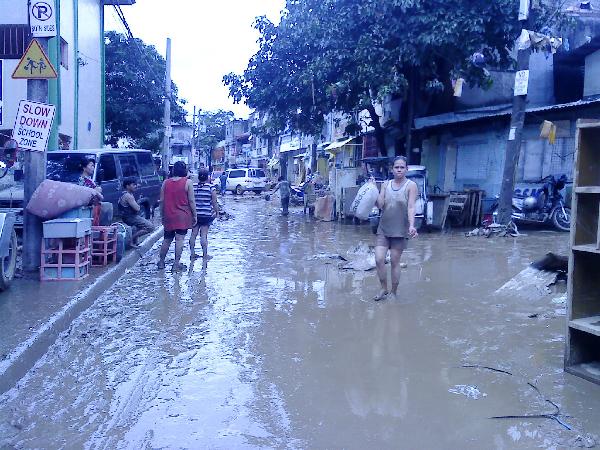by Pesante-USA
Tuesday, Oct. 27, 2009 at 1:07 PM
magsasakapil@hotmail.com 213-241-0906 337 Glendale Blvd. Los Angeles, CA 90026
The United States on Monday announced it was giving $8.5 million (about P399 million) in food aid to the Philippines to help it recover from back-to-back storms that killed more than 900 people.
But for the Pesante-USA, we ask is this real aid or just a Trojan horse for more benefits for the US in the future?
Pesante said this comes at the heels of Tropical Storm “Ondoy” (international codename: Ketsana) last month triggered the worst flooding in Metro Manila in more than 40 years, and Tropical Storm “Pepeng” (Parma) early this month caused deadly landslides.
The two storms killed 929 and flooded the homes of more than seven million people. The damage in agriculture alone has reached more than P21 billion. More than 25% of agriculture of the island of Luzon was destroyed in 27 provinces affected more than 20 million people. The twin disasters exposed the utter neglect and inutility of the US-Arroyo regime in handling the disasters and helping the people.

mud_after_floodwaters.jpgcvwas2.jpg, image/jpeg, 2048x1536
PESANTE NEWS
October 26, 2009
$8.5-M US food aid to RP, Real Aid or Future Business Edge?
MANILA, Philippines—The United States on Monday announced it was giving $8.5 million (about P399 million) in food aid to the Philippines to help it recover from back-to-back storms that killed more than 900 people.
But for the Pesante-USA, we ask is this real aid or just a Trojan horse for more benefits for the US in the future?
Pesante said this comes at the heels of Tropical Storm “Ondoy” (international codename: Ketsana) last month triggered the worst flooding in Metro Manila in more than 40 years, and Tropical Storm “Pepeng” (Parma) early this month caused deadly landslides.
The two storms killed 929 and flooded the homes of more than seven million people. The damage in agriculture alone has reached more than P21 billion. More than 25% of agriculture of the island of Luzon was destroyed in 27 provinces affected more than 20 million people.
The twin disasters exposed the utter neglect and inutility of the US-Arroyo regime in handling the disasters and helping the people.
Pesante laments that the US-Arroyo regime is seeking $74 million in foreign assistance through the United Nations for food, water, sanitation facilities and health care. The US official said their aid was separate from that request.
US Aid with Interests
US Agriculture Secretary Tom Vilsack, calling on President Gloria Macapagal-Arroyo, said the aid, consisting of 7,000 metric tons of rice and 680MT of dry milk, could feed nearly half a million people for two months, officials said.
The food aid “will help the people in most need of assistance, and as a longstanding friend and partner of the Philippines, the US stands ready to continue our cooperation and assistance in the future,” Vilsack said in a statement.
Anthony Golez, deputy presidential spokesperson, said Vilsack brought with him a 20-man US trade mission to “further solidify direct commercial relations between US and Philippine producers, processors, traders and investors.” Golez said the US official was leaving on Tuesday for China but the business delegation would stay until the end of the week to look into trade opportunities in places like Davao.
The US motives was very clear. “They are going to see the potential of handling businesses here in the country and at the same time see the potential of joint ventures with Filipino businessmen,” Golez said.
US interests on Feed stocks development and biofuels research
Vilsack also told reporters on the sidelines of a trade and investment conference in Makati City that US businessmen were looking for partnerships in biofuel research to lessen dependence on petroleum products which are being blamed for global warming and climate change.
“We’re looking at a relationship and partnership with the Philippines in terms of research on biofuels. We recognize and appreciate that you’re faced with the same challenges we’re faced with. You don’t want to be reliant on one form of energy, energy that you do not necessarily control. I’m sure that we’ll continue to share information, knowledge and discoveries,” Vilsack said.
The secretary said the US Department of Agriculture was spearheading policies to maximize productivity in corn-based biofuels.
“There are a number of researches and projects focused on developing second- and third-generation feed stocks for synthetic fuel. I’m convinced that in time we’ll see a mix and balance but right now, our productivity is fairly significant and there are indications that we have not maxed out our productivity,” Vilsack added.
He said US scientists were looking at grass, fast-growing trees, livestock manure, biomass and a variety of other options to use not just for feed but for producing ethanol and other more environment-friendly fuel.
Vilsack, a former governor of Iowa, said the USDA was also helping American companies find investment opportunities in the Philippines in the trade of vegetables and fruits that are considered “cash crops.”
*********

